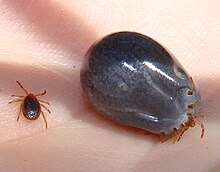
Back Ixodes holocyclus CEB Ixodes holocyclus Spanish Ixodes holocyclus French Shash bizaʼazis hólóní biyaʼ NV Ixodes holocyclus Russian Ixodes holocyclus Turkish
| Ixodes holocyclus | |
|---|---|

| |
| Ixodes holocyclus before and after feeding | |
| Scientific classification | |
| Domain: | Eukaryota |
| Kingdom: | Animalia |
| Phylum: | Arthropoda |
| Subphylum: | Chelicerata |
| Class: | Arachnida |
| Order: | Ixodida |
| Family: | Ixodidae |
| Genus: | Ixodes |
| Species: | I. holocyclus
|
| Binomial name | |
| Ixodes holocyclus | |

| |
Ixodes holocyclus, commonly known as the Australian paralysis tick, is one of about 75 species in the Australian tick fauna and is considered the most medically important. It can cause paralysis by injecting neurotoxins into its host. It is usually found in a 20-kilometre wide band following the eastern coastline of Australia. Within that range, Ixodes holocyclus is the tick most frequently encountered by humans and their pets. Because the same area includes Australia's most densely populated regions, bites on people, pets and livestock are relatively common.
Paralysis ticks are found in many types of habitat, particularly areas of high rainfall such as wet sclerophyll forest and temperate rainforest.[2] The natural hosts for the paralysis tick include koalas,[3] bandicoots, possums and kangaroos.[2]
- ^ Cite error: The named reference
Neumann 1899was invoked but never defined (see the help page). - ^ a b "Ticks". Department of Medical Entomology, University of Sydney and Westmead Hospital. Archived from the original on 2022-04-22. Retrieved 2005-11-29.
- ^ http://www.tickalert.org.au/ntivefna.htm Archived 2009-09-28 at the Wayback Machine Tick poisoning in native Australian fauna